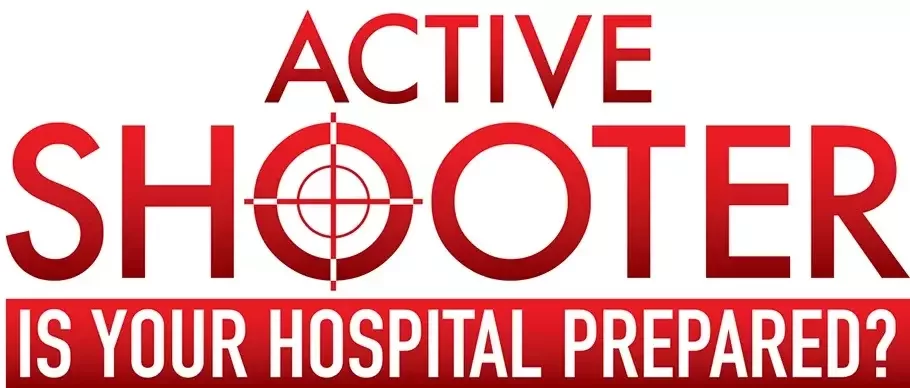
This morning, again in the headlines, “Gunman kills 2 at Parrish Medical Center” (Rosin, 2016) – what is going on in our hospitals, as it seems that every week there’s at least one hospital shooting incident, which nearly always claim innocent lives? What can be done to ensure visitor, staff and patient safety, should an active shooter event occur at YOUR hospital?

Definition of Action Shooter
First, let’s define what the term “active shooter” is. According to the Federal Bureau of Investigation (FBI), an “active shooter” is one or more individuals that are “actively engaged in killing or attempting to kill people in a confined and populated area” (Healthcare and Public Health Sector Coordinating Council, 2015).
With as much as these incidents are hitting the news recently, I found it unusual that there isn’t raw data on its frequency and occurrence. In my research, I did find a study from Johns Hopkins that was published by the Annals of Emergency Physicians back in 2012 where the researchers analyzed US hospital-based shootings from 2000-2011. Please see some facts and statistics in the infographic below, but I do encourage you to read through their highly detailed study, as it is rich with information that is pertinent to all US healthcare facilities.

Preparing an Active Shooter Plan
Preparing for an active shooter incident can be daunting for hospitals as they are unpredictable and tend to quickly occur without much warning and “because active shooter situations are often over within 15 minutes, before law enforcement arrives” (The Joint Commission, 2014); staff must be ready to deal with this type of incident BEFORE law enforcement arrives.
When developing a formal plan, it MUST have input from local law enforcement agencies, as well as many disciplines throughout the hospital (facilities, nursing, leadership, emergency management, etc.) as each group of stakeholders will have a significantly different viewpoint based on their role within the hospital structure.

Example Active Shooter Plan
Below is an example of a plan taken from the Active Shooter Plan that the FBI has for use on its website. The bullet points identify some of the items that should be contained (at a minimum) in any facility’s response plan:
1) A preferred method for reporting active shooter incidents
Consider how you will notify law enforcement or other external emergency resources
Development and use of an internal facility-wide code, such as “Code Gray” / “Code Silver” or text message alerts
Examine how the facility will alert those patients and visitors with communication barriers (vision, hearing, and language)
2) An evacuation policy and procedure
3) Emergency escape procedures and route assignments (i.e., floor plans, safe areas)
Consider alternative routes if the main escape routes are unsafe
4) Lockdown procedures for individual units and locations and other campus buildings
Do some areas need to be designated as shelter-in-place or “safe” areas?
Consider what procedures would be appropriate for high-risk or specialized areas, such as MRI, Psych, ORs, and others
5) Integration with the facility Emergency Operations Plan and Incident Command System
6) Information concerning local area emergency response agencies and hospitals (i.e., name, telephone number, and distance from your location)
Plan to ensure that it is easily accessible for ALL staff at ALL times
In addition, the plan should also address how the hospital active shooter patient safetyand its staff plans to respond to any “other gun-related incidents (e.g., a single shot fired, possession of a weapon on campus)” (Healthcare and Public Health Sector Coordinating Council, 2015) that may occur on their grounds, as this may be a more frequent incident that needs to be adequately addressed and managed so it does not escalate into an active shooter situation.

The First Step to Getting Started
Creating the plan is only the first step. In upcoming blogs, I will discuss training staff and role responsibility when responding to threats that occur within the hospital. Until then, I hope you take a few minutes to read the study by Johns Hopkins, as well as the FBI’s Active Shooter Planning and Response document – I believe you will find them very valuable as you start to make sure that your hospital is prepared for the unthinkable.
New Infographic: 4 Musts for High Reliability Hospitals

WORKS CITED
Healthcare and Public Health Sector Coordinating Council. (2015, April 17). Active Shooter Planning and Response in a Health Care Setting. Retrieved from FBI: https://www.fbi.gov/file-repository/active_shooter_planning_and_response_in_a_healthcare_setting_2015.pdf/view
Kelen, G. D., Catlett, C. L., Kubit, J. G., & Hsieh, Y.-H. (2012). Hospital-Based Shootings in the United States: 2000 to 2011. Retrieved from Med Page Today: https://www.medpagetoday.com/upload/2014/5/1/fa-gdkelen.Pdf (link no longer available)
Rosin, T. (2016, July 18). Gunman kills 2 at Parrish Medical Center. Retrieved from Becker's Hospital Review: http://www.beckershospitalreview.com/hospital-management-administration/gunman-kills-2-at-parrish-medical-center.html
The Joint Commission. (2014, July 28). Preparing for active shooter situations. Retrieved from The Joint Commission: https://www.jointcommission.org/issues/article.aspx?Article=h1wY0qOAjXjKMD9Np15aXCoh6JDFt4iaFxb//TKfNWE=
